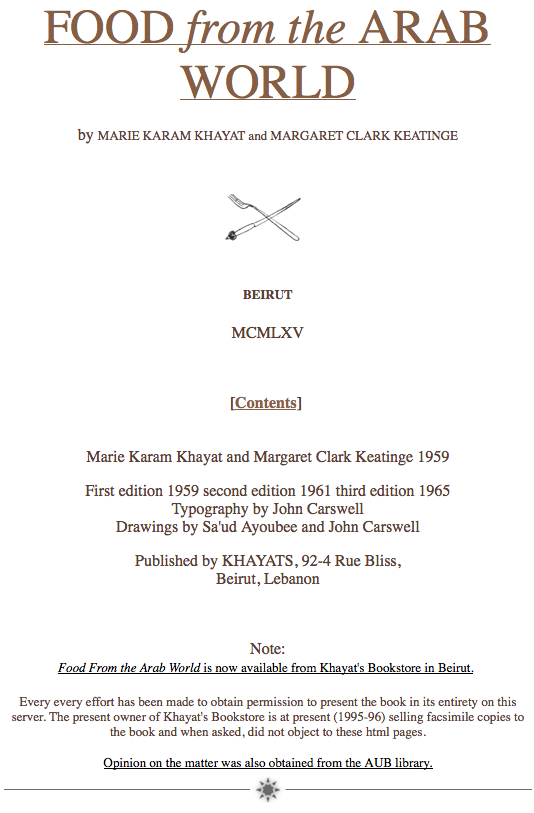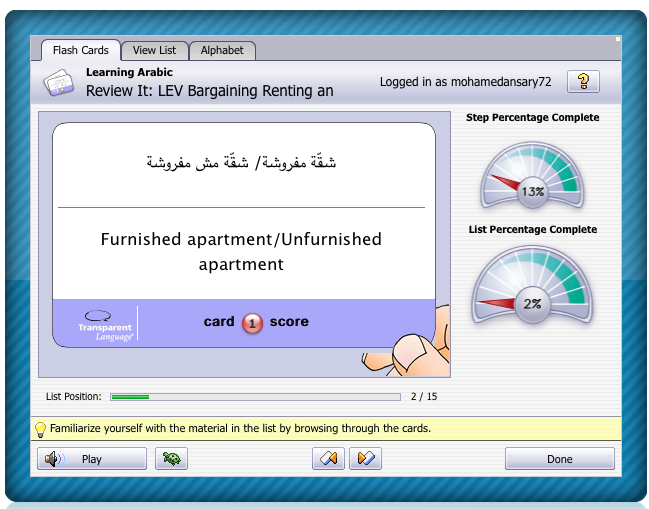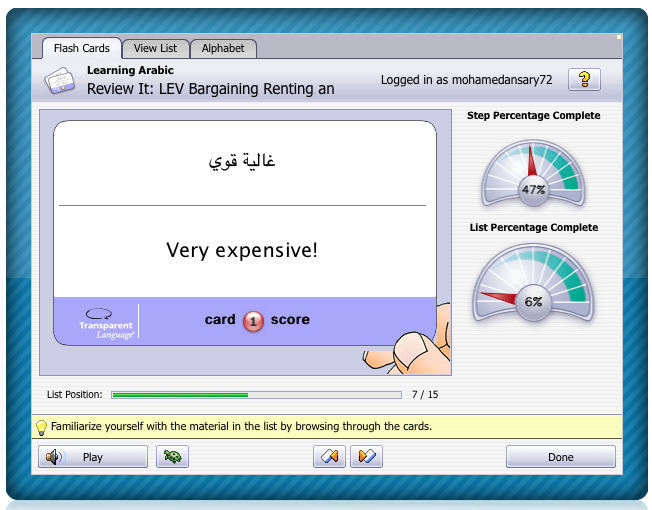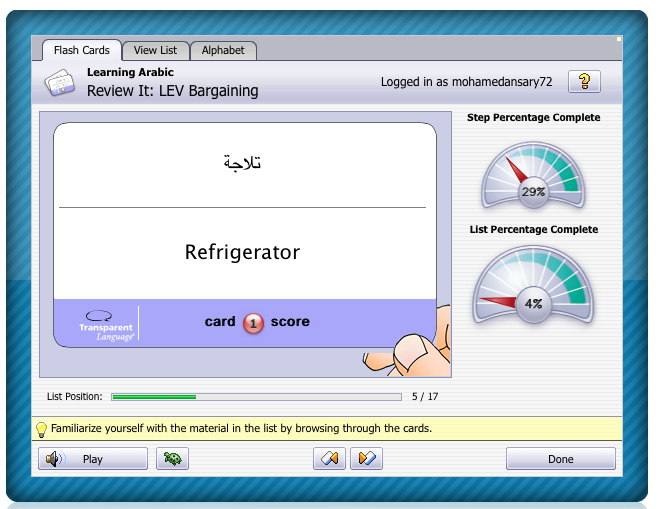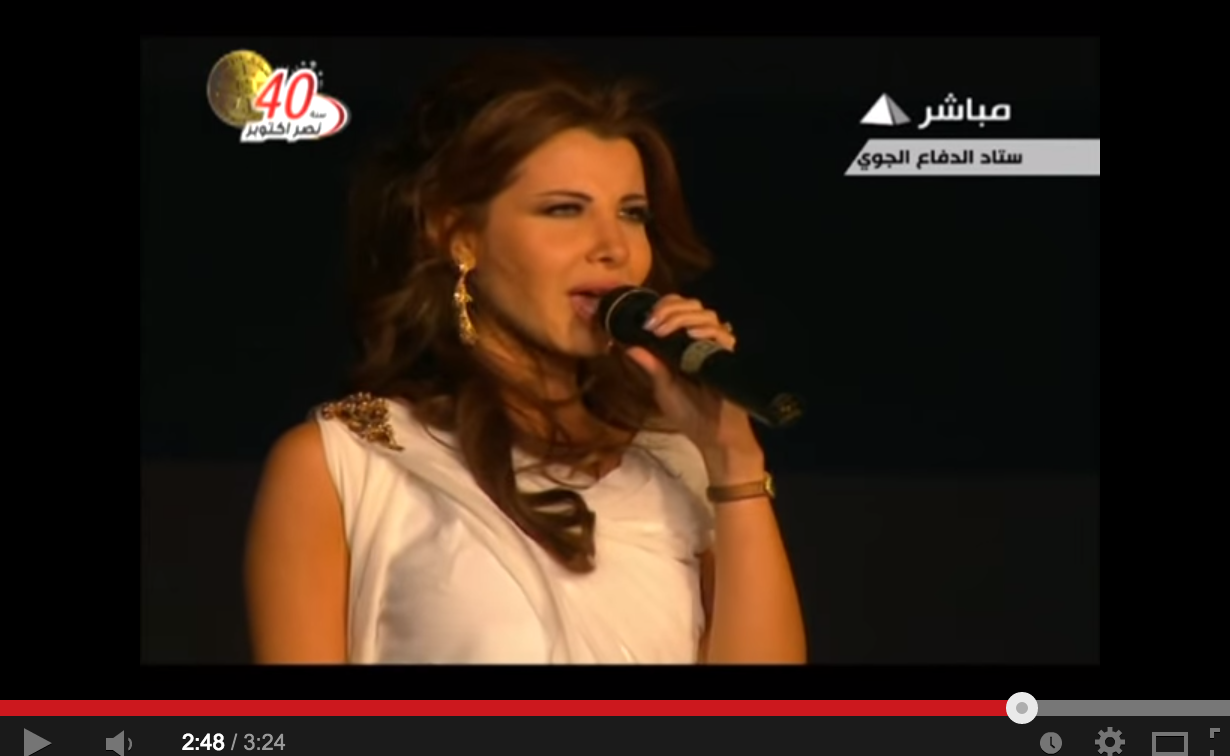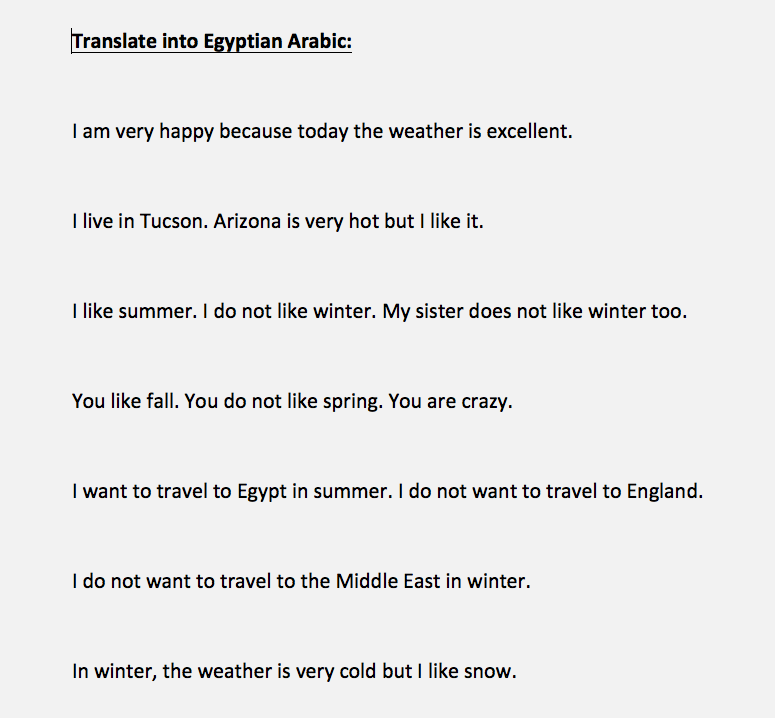========================================
http://www.arabick12.org
Culture
الثقافة العربية
=============
Al-Bab.com provides many links to various Arabic language sites that might be interesting to students, including information on the Arab world and culture. This site tries to serve as a portal and much of the information provided is in English.
Good collection of links, well organized and plentiful; not all links work.
Al-hakawati is a free educational resource and reference made possible by the Arab Cultural Trust. The goal is to reach as wide a readership as possible, to provide each visitor to the website with a virtual library of Arab heritage, to make learning and knowledge about the Arab world available to all, and to promote understanding of Arab culture in the Arabic-speaking world and in the West.
In English and Arabic, in the process of being updated, excellent cultural resource.
A site of online recipes in Arabic.
Difficult to navigate, especially for non-native speakers. Website sometimes has problems loading properly.
This site describes in clear language the history of many forms of Arabic calligraphy and the alphabet. It also provides good images.
Easy to navigate, lots of images and useful information.
A website in English with recipes, names and cooking terms in Arabic, and some cultural notes. Offers transliterated Arabic equivalent for food and spices.
Many links do not work, recipes’ measurements are in the metric system.
Basic facts about the country, such as geography, people, government, economy, communications, transportation, military, and transnational issues.
Reliable information. Country descriptions are regularly updated.
Many recipes that can be used in classrooms to teach the cuisine of the Middle East. Recipes are primarily Levantine.
Easy to follow recipes.
An open lyrics website for traditional and contemporary Arab singers. Contains lyrics in Arabic, transliteration in English, and an English translation for many songs.
Good material for teachers to use with students.
Islamic Art and Architecture Organization |
http://www.islamicart.com/
Detailed descriptions, pictures and histories of Arabic calligraphy and Islamic art, architecture, coins and rugs.
Useful teaching tool with lots of images and also useful for independent research. Some links don’t work.
The site contains the Qur’an in Arabic. Each verse is transliterated and three translation versions are provided. It includes a search feature as well as recordings of each individual aya and each sura as a whole.
Excellent cultural resource, easy, but slow to navigate.
Audio and English/Arabic lyrics of Darwish’s poem “Rita w al-bunduqiya.” A valuable resource to educate about the form of Arabic music (sung poetry), social issues expressed through music, and an introduction to the poetry of Mahmoud Darwish. Selected vocabulary is translated.
For older students, requires RealPlayer.
An open Wiki for Arabic lyrics containing biographies of contemporary popular and traditional artists. Songs are listed by album and include the lyrics in Arabic, transliteration in English, and translated lyrics in English.
Appealing to students and better updated than “Golden Arabic Lyrics.”
Sultan Qaboos Cultural Center|
http://www.sqcc.org/
The “Educational Resources” section contains a variety of useful links and lesson plans for teachers about Oman, the Middle East, and Islam. The resources are divided into elementary, middle and high school sections.
Useful resources for teachers, easy to navigate. Student resources focus on study opportunities.
An online edition of “Who Wants to be a Millionaire?” with questions and responses in Arabic. Designed for native speakers, this game may be difficult for many students—the teacher will want to preview.
Easy to play, difficult to answer!
101 Questions and Answers about Arab Americans|
http://www.freep.com/legacy/jobspage/arabs/
Published by the Detroit Free Press, this site addresses stereotypes of Arab Americans, as well as gives social, cultural, demographic, and religious information in a simple, easily-accessible format. The questions and answers are a good introduction that provides accurate information about Arab Americans.
Easy to access, clearly written. Appropriate for use with middle- and high-school students.
A website linked to the book 1001 Inventions which details a multitude of inventions that have come to the modern world from or through Arab civilization. Includes teacher resources as well as posters.
Website not very useful to teachers without purchase of the accompanying book.
=========================================================
Online Exercises
تدريبات أونلاين
===========
http://www.arabick12.org
Aswast Arabiyya, originally developed at Emory University, has audio files available for download and accompanying activities. The files are listed according to proficiency level with Arabic, with an option to slow down the audio file.
Useful layout, videos well organized according to proficiency level. Videos from the “Index” don’t play and some from “Selections” don’t have sound.
You can study the flashcards on-line with the provided flashcard viewer. There are various study options, like changing the sort order (random, alphabetical by questions, etc.) or viewing only a range of cards, or viewing all flashcards in the card set at once in list format. Flashcards can be printed, imported into Microsoft programs, or synced to Palm Pilot or Windows CE devices.
Accessible for students and teachers with some technological saavy, contains most of the Al-Kitaab vocabulary.
Foreign Language Videos |
http://dmc.ohiolink.edu/
Video clips in which native speakers elaborate on a wide variety of topics about their culture, family, daily life, and more. All videos are in Modern Standard Arabic.
Videos geared toward in-class activities.
An introduction to Arabic-English transliteration, the site provides conjugation information for frequently-used verbs and roots. Examples are taken from the Qur’an.
The conjugation section can be confusing to students not familiar with transliteration.
LangMedia Practical Language Series|
http://langmedia.fivecolleges.edu/
Covers practical aspects of daily life in various countries. The videos reflect authentic linguistic usage including local dialects, colloquial grammar and figures of speech. The series assumes minimal knowledge of the language. It is useful for persons preparing to study or work abroad and for cultural units in beginning language courses. Many of the exercises are tied to Al-Kitaab.
Videos are useful, plentiful, and accessible to students.
Teaches simple grammar and vocabulary. The grammar section can serve as a supplemental resource for beginning students.
Elementary, focuses on grammar and reading.
Female and male voices speaking on a variety of topics ranging from family and weather to social issues, history, and politics. Tunisian dialect. Very clearly and slowly spoken.
Teachers must have RealPlayer installed and be familiar with playing and downloading web audio.
The UCLA Language Materials Project |
http://www.lmp.ucla.edu/
A database of materials organized by language (including dialects), material type, language-learning level, and audience. Language profiles for Modern Standard Arabic as well as a few regional varieties are provided.
Teachers may find it will take some time to sort what they are looking for.
A portal for foreign language learning and teaching. Students can create vocabulary flashcards or use flashcards created by other users. Web Reader allows students to view foreign language web pages with translations in the scroll-over. (Free registration required)
Free registration required.
=========================================================
Arabic Media
الإعلام العربي
==============
Al Waraq is a broad resource for students and teachers about Arab culture, including art, literature, folklore, and religion. It includes both text and audio materials, and access to several famous works of literature in Arabic.
Requires registration, a little hard to navigate.
News, sports, weather, etc in Modern Standard Arabic.
Full news coverage in Modern Standard Arabic.
Dar Al Hayat’s website is a source of information for readers seeking in-depth reporting on the Middle East and the Arab world, in Arabic.
Easy to navigate, especially for students. For use with high intermediate and advanced students
Deutsche Welle Worldservice |
http://www.dw-world.de/
Germany’s international broadcasting service offers multimedia, globally accessible information in 31 languages.
Full news coverage in Modern Standard Arabic.
A comprehensive collection of media by country and language.
Well-updated links.
A Jordanian website of social and political cartoons, primarily by Emad Hajjaj. Includes caricatures and animations in Arabic, some of which are translated into English.
Easy to use in Arabic and in English.
The Middle East Media Research Institute (Memri) maintains a collection of media video clips from the Middle East, including surrounding areas like Turkey, Iran, and Afghanistan. Clips usually have an English text translation at the bottom of the screen and are organized by topic.
Excellent layout. Teachers should be careful in choosing the videos to view with students.
Part of a larger website (
www.nesnas.com/ is similar to Yahoo!), the news portion has links to major newspapers in the Arab world, as well as foreign newspapers and websites in Arabic.
Good set of primary source links. Comprehensive.
Daily news in audio and transcript. On demand and live. Includes archives.
Crowded website, but a good resource.
The most comprehensive radio station search-by-country engine with links to over 10,000 radio station web pages and over 2500 audio streams from radio stations in the U.S. and around the world.
A potentially good resource but not all links are active and sometimes it is hard to connect to stations.
Links to newspapers and magazines throughout the Arabic world. Organized by country.
Easy to navigate, links are more useful than the “News” portion of the website.
=======================================================
Resources
مصادر
=============
Online Arabic Dictionaries:
Online Arabic keyboard for students using computers not formatted to type in Arabic. Tedious, and should only be used for single words—useful for typing words in Arabic to look up in online dictionaries.
Links to multiple online dictionary and translation resources.
Online Arabic-English, English-Arabic dictionary.
Online Arabic-English, English-Arabic dictionary.
A collection of links to online dictionaries.
A brief introduction to the structure and terminology of Arabic grammar.
In Arabic (for advanced students), basic and easy to navigate.
A brief theoretical introduction to Arabic grammar, including the proper terms and usages for various grammatical terms.
In Arabic (for advanced students), easy to navigate.
Linguist’s Software offers foreign language fonts for Arabic/Farsi.
Available for purchase.
A list of free teacher materials (CDs, posters, teaching modules) for Arabic teachers. Either available for download online or by request from the U Penn Middle East Center.
Description of materials.
A pictorial vocabulary guide, with a brief introduction to the alphabet and grammar and several pages of vocabulary. Contains a lot of detail, especially with body parts, animals, etc and can be used to supplement. Audio provided.
Easy to navigate, useful for vocabulary. Clear sound.
The sections on Arab countries, newspapers, radio/TV, Islamic arts, Islamic sites, mosques and museums on this site provide good links for cultural and art resources.
Good resources, useful links.
========================================================
Professional Resources
مصادر مهنية
للمشتغلين بمهنة تدريس اللغة العربية
================
American Association of Teachers of Arabic |
http://aataweb.org/
American Association of Teachers of Arabic (AATA) aims to facilitate communication and cooperation between teachers of Arabic and to promote study, criticism, research and instruction in the field of Arabic language pedagogy, Arabic linguistics and Arabic literature.
Networking resource, complete with listserve and teacher resources directed specifically towards Arabic teachers.
The Center for Advanced Research on Language Acquisition |
http://www.carla.umn.edu/
CARLA’s mission is to study multilingualism and multiculturalism, and the site has a Less Commonly Taught Languages database, along with other resources for teachers of LCTLs.
Organized, working links.
Middle East Studies Association (MESA) | http://mesa.wns.ccit.arizona.edu/
MESA is a private nonprofit, non-political organization of scholars and other persons interested in the study of the Middle East, North Africa and the Islamic world.
Good networking opportunity for teachers of Arabic and scholars. The AATA meets with MESA.
National Capital Language Resource Center – Teaching Essentials |
http://www.nclrc.org/essentials/
This website is part of the NCLRC website. It includes information regarding language teaching and the best and most recent theories and methodologies in language teaching. This website is very useful for language teachers not only for Arabic language but also, for other languages as it helps teachers to identify their method of teaching and evaluate themselves to better their teaching.
Forthcoming in Arabic.
National Middle East Language Resource Center|
http://www.nmelrc.org/
The National Middle East Language Resource Center, through Brigham Young University, coordinates the efforts of teaching Arabic and other Middle Eastern languages in the United States. They have several projects including teacher training, materials development, testing and assessment, integration of pedagogy and technology, study abroad, and K-12 programs.
Excellent collection of links. For students and teachers alike.
=====================================================
Curricula and Curriculum Development
تطوير المناهج الدراسية
================
Bureau of Islamic Arabic Education |
http://www.biae.net/
The website of the Bureau of Islamic Arabic Education (BIAE) has developed a set of materials in Arabic for K-3.
Carefully designed curriculum with supporting materials.
Interagency Language Roundtable (ILR) |
http://www.govtilr.org
Homepage of the federal Interagency Language Roundtable which established the foreign language proficiency scale used by federal agencies to rank an individual’s language skills. In addition to information on languages in the government, the site has a large webliography of Less Commonly Taught Languages (LCTLs). Available resources can include socio-historic language sketches, introductions to writing systems and phonologies, beginning and intermediate online tutorials and exercises, online dictionaries, media sites, cultural and target country materials, etc.
Easy to navigate.
This website is an Arabic language curriculum for K-12. The link has information and guided instruction about teaching the Arabic language for each grade level. Arabic language teachers who have not been in an American classroom may benefit from this link.
Islamic-based Curriculum.
The Marhaba! Project is a standards-based high school curriculum for first year Arabic. The curriculum is part of a three year project funded by the US Department of Education, and is available at no cost to public and private schools.
Simple website outlines the basics of the curriculum project including videos of students in the program.
Project Aero provides K-12 educational standards for various subjects and provides schools and educators with resources to develop their own specific standards. The World Languages standards closely mirror the ACTFL Standards for Foreign Language Learning in the 21st Century, but are designed to meet the needs of overseas schools.
Organized, informative and clearly articulated.
A very good example of a curriculum designed to teach Arabic to non-native speakers in high school, including broad goals for three levels of Arabic, their connection to the ACTFL Guidelines, and month-by-month outlines.
Excellent teaching resource.
==================================================
Other
مصادر أخرى
===========
Arab Academy’s Arabic Language Proficiency Test|
http://www.arabacademy.com/en/alpt
Includes information related to the Arab Academy’s Arabic Language Proficiency Test, a language assessment test for the Arabic language. Information is provided on how the test is administered and the ACTFL proficiency scale guidelines. Test registration procedures are also available.
Useful resource for teachers looking for a structured language assessment.
An organized collection of links about the Arabic language and tools for learning Arabic (online courses, online grammars and dictionaries).
Has some links not available in other places.
Working links, organized.
Collection of e-links on Islamic studies, the majority of which are academic and well-respected.
Good links, well-organized.
===================================================


